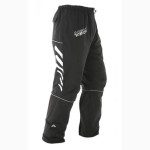Men in tights. Women in tights. It’s a cycling rite of passage to brave up to pulling on the full length Lycras. Here’s what to look out for when you’re browsing for winter tights.
If you want to keep cycling outdoors during the cold winter months layering up will keep you warmer and more comfortable and that also goes for your legs.
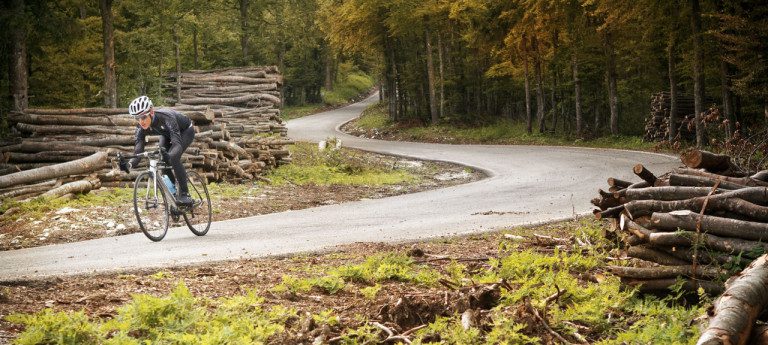
Cycling tights are designed to keep your lower limbs warm when the weather turns bad and by covering the knees it also helps prevent cold related stresses and injuries to sensitive muscles.
Although they may look like longer versions of Lycra cycling shorts, they are thicker and far more technical than they look.
Like most things in cycling, although they all look similar there is a bewildering choice of tights available each with their own technical specification making them better for certain conditions or users.
Here’s a few pointers to help you chose the right cycling tights for your needs.
Bib or non-bib
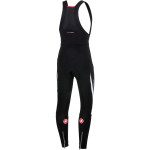 The first thing to decide is whether you want bib or non bib tights. Bibs help prevent the tights from slipping down at the waist and therefore keep the tights in an overall better position. Bibs also allow for a higher waist which helps keep the stomach warm.
The first thing to decide is whether you want bib or non bib tights. Bibs help prevent the tights from slipping down at the waist and therefore keep the tights in an overall better position. Bibs also allow for a higher waist which helps keep the stomach warm.
Non bib tights have an elasticated waist making them more practical for women, toilet stops mean you don’t have to take off all your upper body layers to get the bibs down.
Thankfully the range of female specific bib tights with ingenious ways of dealing with straps over the bust and still easy to remove is growing all the time.
Material and thickness
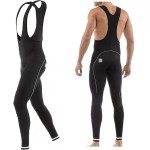 (this is an old post and the linked content no longer exists)There is quite a range of thicknesses to choose from to suit all weather conditions from lightweight spring /autumn versions to heavyweight ‘deep winter’ versions
(this is an old post and the linked content no longer exists)There is quite a range of thicknesses to choose from to suit all weather conditions from lightweight spring /autumn versions to heavyweight ‘deep winter’ versions
The material will be thicker than normal cycling shorts and usually features a ‘Roubaix’ inner which is a soft fleece making them warmer and more comfortable.
Most manufacturers are introducing some form of water repellent membrane into tights making them even more comfortable and for really foul conditions some even have wind fronted panels to keep the chill out.
The only drawback is the more features the higher the cost but thankfully none of the bulk.
Fit and features
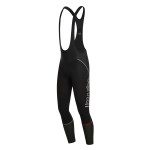 Once you’ve decided on bibs and thickness the fit is crucial. Make sure they are tight enough to remain in place but don’t restrict movement especially at the knee.
Once you’ve decided on bibs and thickness the fit is crucial. Make sure they are tight enough to remain in place but don’t restrict movement especially at the knee.
Tights are made from several panels stitched together and the number of panels and placement of stitches can greatly influence the fit.
Placement of padding, can also affect how tights feel so when trying on make sure you get down in to a crouched cycling position to see how they feel.
Some manufacturers even pre-shape certain areas, mostly the knee, so again if they feel odd standing up get into a cycling position for feel.
Sizing can vary between manufacturers so don’t be alarmed if you have to change sizes from the usual. Subtle features can also aid comfort mainly how they are kept in place at the waist and ankles.
If you go for bib versions make sure the straps are wide so they don’t cut in and if they have a high waist then a zip is useful to aid for comfort stops.
I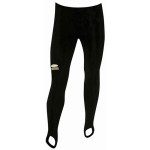 f going for non bib then some sort of adjustment at the waist is better.
f going for non bib then some sort of adjustment at the waist is better.
Another feature which divides cyclists is how the tights are kept in place at the ankle.
Some have a thick elasticated loop; some are zippered and some use a foot loop which people either love or loathe and will take great pleasure in telling you why.
A lot of manufacturers are also incorporating reflective panels into tights to break up the black and help make you more visible in low light conditions, handy as they’re mostly used during
the dark winter months when you need it most.
Padding or no padding
Depending on model some tights have a chamois and some don’t and boy can people get really hung up on this. Some prefer to have padding so they don’t have to wear shorts underneath while others prefer not to have padding as they will be using them with ordinary cycling shorts underneath.
You can wear shorts underneath even if your tights have a chamois without restricting movement so if you find a pair of tights you like then get them regardless of padding. Padded or not, the choice is yours
 Don’t like the lycra look?
Don’t like the lycra look?
If you don’t like the Lycra look but still want to cover the legs then a pair of over trousers will do the trick.
These are favoured by mountain bikers and commuters as they can be worn over cycling shorts or normal clothing but still provide protection on the bike.
Cycling specific versions are shaped to make them easier to use while cycling and are packed with features which cyclists will really appreciate in use.
Which winter tights should you buy?
First timer user – a simple pair of non bib tights is a great way to keep warm without the cost. They are easy to use over your cycling shorts and don’t worry if you have double chamois. A good waist and ankle gripper is all you need to keep them in place.
Regular cyclists will appreciate a bib version as they stay in place better and tend to be better made to withstand more usage. Thicker materials and a high waist will keep you warmer, and zips or foot loops on the ankles will keep them in place round the knee and ankle
Experienced cyclists – a good set of tights is a must. They will be very well constructed using the latest water and wind repellent materials as well as warmer and more comfortable to wear. They will be pre-shaped so will fit better and bibs are a given. Ankle securement can vary just make sure whatever system it is works with your overshoes, most manufacturers realise this anyway so make ankle securement non obtrusive.

